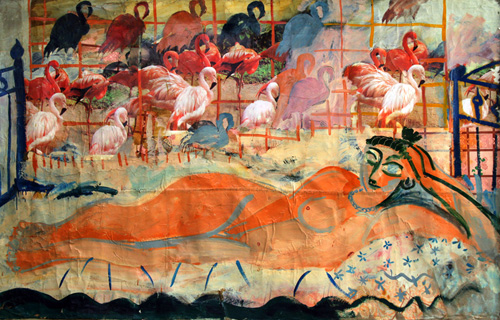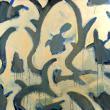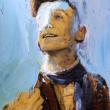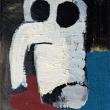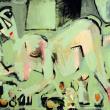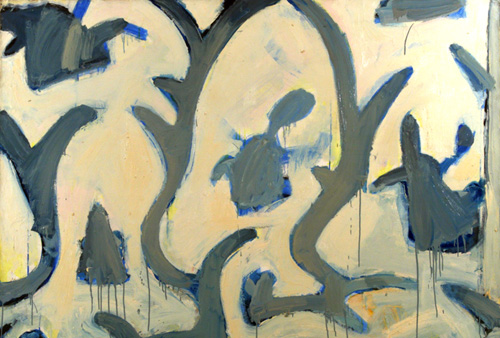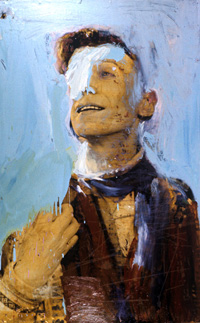DAVID RIFF saw many chickens, one moray eel, and one very good exhibition of avant-gardists from the 1980s
On the second day of the Third Moscow Biennial, I went to the Garage to see some presentations by the artists of the biennial's main project. Jean-Hubert Martin was riding around on a scooter, everything was almost finished, Wolfgang Tillmans was hanging his work, Joseph Backstein and other VIPs were already having a pre-shmooze in front of a huge half-cheese made of red vaseline that overshadows both Osmolovsky and Chaim Sokol. Artists were giving one hour presentations, one after another. Curated by Yulia Aksionova, this mediation marathon is a brilliant effort, but the Moscow public seemed too busy or too exhausted by all the parallel projects. So, again, overkill is to blame, and maybe also Garage's somewhat forbidding haute bourgeois public image, with secret-service-style security, as if an exhibition montage involved the assembly of secret weapons whose technologies should not fall into the wrong hands.My first impression of the show: ambivalent, to put it diplomatically. On the one hand, I appreciate the effort. With the help of competent organizers, Jean-Hubert Martin has created the "perfect" spectacle, very well done as far as spectacles go, very consistent in itself. And I have a feeling that the Moscow public will like if not love all these stuffed animals and live birds, these huge cheeses, patterns, and spiderwebs that crash into one another in unexpected Kunstkammer confrontations. The Russian artists fit right into this potpourri of curatorial pyrotechnics. Alfredo Jaar told me that it was like an anniversary show of Magiciens de la Terre, part of which was originally held in La Villette, a similarly post-industrial space with a similarly exotic, post-colonial content. What does it mean to make such a show for Moscow? Let's collectively ask ourselves that question. Does Russia play the role of the West? Where do you locate Russian ethnopoetics in that equation?
At the Garage, I ran into Dima Gutov, who didn't have an answer for that question (or maybe his work is his answer). We made our way to GMG Gallery, which was hosting an exclusive event right before the VIP preview of Art Moscow with the provocative theme "Are collectors sharks?," and there was even a morene (shark-like fish) in an aquarium at the entrance of GMG to illustrate this "provocative" theme. The discussion was hosted by John Varoli of the Art Newspaper, with guests such as collectors Pierre Brochet and Dmitry Kovolenko, art manager Nikolai Palashenko, and Forbes Russian editor-in-chief Maxim Kashulinsky, as well a guest from Kiev. A strange discussion: Pierre Brochet openly compared himself with Shshukin (that's what my name means in French, he said to Dima Gutov), and claimed that the real "geniuses" behind art were the people who support artist and comission works, i.e. collectors. Editor-in-chief Milena Orlova that the real sharks were the critics who tear anything connected to the market to pieces for ideological reasons. She clearly meant OPENSPACE.RU. Dmitry Kovolenko had a very intelligent and honest response: "The market gets in my way as a collector." Dima Gutov said that the real sharks were elsewhere, in Los Angeles or New York. The buffet had four variations of tiger prawns, and they weren't the only thing that made me feel a little ill.
The last stop on my second night out was the show "Art or Death" at the Moscow Museum of Modern Art, which features early paintings and collages by artists from Rostov. Avdej Ter Oganian and Valery Koshlyakov stand out as utterly unbelievable masters of the brush remarkably current for the 1980s despite their total isolation from Western Europe, where the painting of Young Wild German painters was taking the market by storm. But in Rostov, far from any market, people were doing similarly explosive things with paint on canvas. Avdej's early paintings belie an unbelievable virtuosity that he later systematically challenged, recontextualized, and destroyed, while Koshlyakov's earliest collages can measure up to any Dadaist or neo-Dadaist collages. It was also nice that the paint on the walls of this space were peeling, and we can only hope that a museum buys this body of work before it is gobbled up by the collectors, who are sharks after all.
- 29.06Московская биеннале молодого искусства откроется 11 июля
- 28.06«Райские врата» Гиберти вновь откроются взору публики
- 27.06Гостем «Архстояния» будет Дзюнья Исигами
- 26.06Берлинской биеннале управляет ассамблея
- 25.06Объявлен шорт-лист Future Generation Art Prize
Самое читаемое
- 1. «Кармен» Дэвида Паунтни и Юрия Темирканова 3452021
- 2. Открылся фестиваль «2-in-1» 2343513
- 3. Норильск. Май 1269125
- 4. Самый влиятельный интеллектуал России 897815
- 5. Закоротило 822338
- 6. Не может прожить без ирисок 783381
- 7. Топ-5: фильмы для взрослых 760192
- 8. Коблы и малолетки 741426
- 9. Затворник. Но пятипалый 472415
- 10. ЖП и крепостное право 408078
- 11. Патрисия Томпсон: «Чтобы Маяковский не уехал к нам с мамой в Америку, Лиля подстроила ему встречу с Татьяной Яковлевой» 403680
- 12. «Рок-клуб твой неправильно живет» 370995

